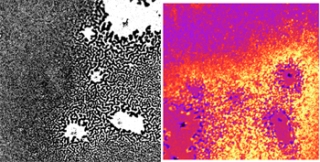Feb 4 2015
A research team at the University of Maryland (UMD) and the National Institute of Standards and Technology (NIST) has successfully determined the phenomenon of pole shift in thin cobalt films on the largest scale ever.
Thin cobalt films appear to spontaneously change their poles, which normally does not occur without an external magnetic field. The study was published in Physical Review B.
 (Left) Polarization sensitive light microscopy shows the pattern of north poles (black) and south poles (white) on thin layer of magnetic cobalt. (Right) The researchers found that the pattern of north poles and south poles spontaneously fluctuates over time. Strongly fluctuating areas are encoded here as brighter colors. Images show an area approx. 75 micrometers across. Credit: Balk / NIST
(Left) Polarization sensitive light microscopy shows the pattern of north poles (black) and south poles (white) on thin layer of magnetic cobalt. (Right) The researchers found that the pattern of north poles and south poles spontaneously fluctuates over time. Strongly fluctuating areas are encoded here as brighter colors. Images show an area approx. 75 micrometers across. Credit: Balk / NIST
The majority of magnets are permanent, meaning a strong magnetic field has to be applied to reverse their north and south poles. This permanence allows the use of small magnets in hard disc drives to store information efficiently. The Earth’s magnetic field can be detected through smartphone compasses using nanomagnetic sensor technology.
However, to detect and create such magnetic fields, a large amount of energy is required. In order to make these devices more energy efficient, more sensitive magnets, which can be easily influenced by electric or magnetic fields, would be required. On the other hand, when these magnets are sensitive, they also tend to become more unstable, shifting from north to south and then back again, even in the absence of a magnetic field.
The researchers mapped this unique instability in a cobalt film of just a few atoms thick, and then ascertained the conditions at which the instability originates. According to the researchers, the continuous flipping of the magnetic poles in thin cobalt films can help significantly in the development of magnetic technology.
These cobalt films can serve as highly sensitive magnetic test beds. To that end, a large number of proposed devices employ ferromagnetic material layers that need to be independently controlled by electric fields to make them both practical and efficient.
Electric fields cannot influence the majority of magnetic materials that are highly stable, and it is also unclear whether their proposed magnetic devices will work effectively.
As an alternative, we could make a proposed magnetic device from our unstable film. This way, even if the film were influenced only a very small amount, we would see, for example, slightly more north flips than south flips, and we would know we are on the right track.
Andy Balk
Researcher - NIST
The research team performed the measurements using video-rate Kerr microscopy. This technique is a type of polarized light microscopy that is capable of imaging even fine-grained details of the magnetic state of materials. If left undisturbed by external effects, the magnetic instability in the cobalt film communicate with each other. A fluctuation from north to south will translate into a matching fluctuation from south to north.
These fluctuations, however, have scale invariance, which means their behavior remains the same irrespective of the length scale on which they are seen, a characteristic they share with unrelated phenomena such as crumpling paper or earthquakes.
The research team is further developing these thin films into highly sensitive field detectors for applications in biomedical and computing fields.